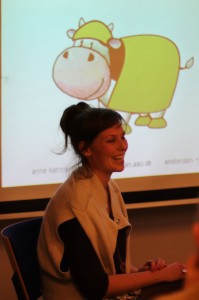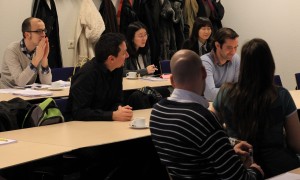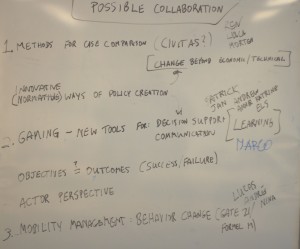
In an earlier post, I described an informal exchange between the transportation planning researchers at the Universities of Amsterdam and Groningen. This week, the University of Amsterdam hosted a similar exchange between our researchers and the fine folks at the University of Aalborg. The idea for the symposium came about last year’s AESOP (Association of European Schools of Planning) conference in Ankara, no doubt through the charisma of our fearless leader, Luca Bertolini.
Luca and Patrick Driscoll (PhD candidate, Aalborg) began the symposium by introducing the group to key issues in transportation planning in the Netherlands and Denmark, respectively. In a session on assessment of transportation plans, Morten Skou Nicolaisen (postdoctoral researcher, Aalborg) summarized his research determining the accuracy of forecasts used in Danish transport project evaluations: he found that for road projects, there is about 10% more demand than expected, while for rail projects there is as much as 30% less demand than expected. Large fixed projects such as major rail infrastructure had the least accuracy; smaller-scale and lower-cost upgrades have the most accuracy. In cases where projects were delayed extensively or scrapped altogether, there was actually 7% less demand than anticipated for the ‘do-nothing’ alternative; this knowledge should impact our valuation of this alternative in our plans. Els Beukers (PhD candidate, Amsterdam) presented her work on using cost-benefit analysis as a learning tool, based on Kolb and Fry’s experiential learning cycle (which I detailed in the post on Groningen). Patrick then presented his work on using ex-post project evaluations as a tool for social learning: we assume that new knowledge will lead to better evaluations, but does it? He discussed several ex-post evaluation attempts, including the Federal Transit Administration’s before and after studies of New Starts projects in the US and the Post Opening Project Evaluation (POPE) of Major Schemes (highway projects costing over £10 million) in the UK. POPE includes a meta-analysis of projects one year and five years after project completion, and has found that the projects give a positive economic outcome, environmental impacts were as expected, and there was no systemic bias.

In a session on transition studies, Andrew Switzer (PhD candidate, Amsterdam) presented his work on the transportation transitions in Munich and Zurich: the history of concrete threats in catalyzing transportation shifts has been observed in both cities (e.g. the threat of climate change, overdependence upon the car manufacturing industry, and loss of historic buildings to road expansion from 1970-1990 was linked to decreased car use). Nina Vogel (PhD candidate, Aalborg) explored Fredericia Kommune in Denmark, a community founded with the aim of reducing CO2 emissions. However, it is located in a very car-dependent part of the country with little transit accessibility, and residents appear to be technical optimists reluctant to pursue transportation demand management routes. Andrès Felipe Valderrama Pineda (postdoctoral researcher, Aalborg) discussed transitions in Copenhagen, which showed the same pattern as many other European and North American cities: a transition to car and bus transit in the 1950s-1970s; slowing of car use, growth in transit, and protests against highway infrastructure in the 1970s-1990s; reinvestment in city centres and increased rail infrastructure from the 1990s-2000s, but still fairly high rates of driving. He took a multi-level perspective to these trends, examining which were rooted in the landscape (very long term, seeing rapid change only through disrupted events), the regime (very stable, rooted in institutions) or niches (short terms of less than ten years, not necessarily local). Michel van Wijk (postdoctoral researcher, Amsterdam) presented his research underway on airport regions which will use Q-methodology to draw strong statements from interviews with transportation and planning practitioners. He will then ask actors who do not know a lot about the topic whether they agree or disagree with the statements, and using Q-sorting will be left with several frames that they can test through serious gaming.

In our final session on conditions to policy success in transport planning, I presented my work on critical success factors in integrating transportation and land use planning: at this time I’m halfway through a meta-analysis of 11 case cities. Anne Katrine Braagaard (PhD candidate, Aalborg) discussed “holy cows” in planning. In her study of Carlsberg Town, architects created a master plan prioritizing cycling and providing less parking, but when it was turned into a local plan and strategies, the municipality allowed the “holy cow” of car use and parking to re-enter, resulting in a watered-down plan. Finally, Jan Duffues (PhD candidate, Amsterdam) presented his study of compact city development in the Netherlands. So far he has found that planning documents attempt to integrate transportation and land use but there is only partial recognition of the effects of densification on the expansion of the car network and little mention of cycling or walking. While transportation planning becomes more prominent and less linked with land use at the higher levels (major projects and initiatives), at the level of project documentation land use is seen as fixed and projects are divided up into pieces so there isn’t an integrated transportation-land use approach–there can even be contradictory outcomes.

The following day, we discussed directions for future partnerships between Aalborg and Amsterdam, including joint sessions at AESOP and the upcoming World Society of Transport and Land Use Symposium in Delft (2014), a couple of joint articles, and coordinating a special issue of a journal on sustainable mobility. Jan and Patrick will explore the use of social strategy games and other gaming possibilities in our research. Luca, Morten and I will explore the idea of comparative case research. Patrick has created an online file sharing environment for us on Podio. We will encourage the development of an informal exchange of Masters and PhD students working in each others’ departments, carrying out research on Danish and Dutch transportation and land use issues. I’d say the first Aalborg-Amsterdam Symposium was a great success, with many of us discovering common interests and research strategies. We will continue to build on these relationships over time, hopefully creating a lasting network of researchers and students exploring issues of sustainable mobility: obviously our countries need our help!
